Now’s the Time to Mulch and Here Are Some Options [Video for Exmark]
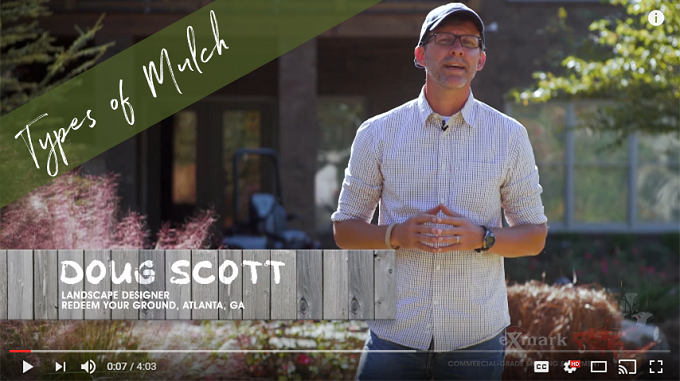
If your yard looks like mine did last week…it’s time to get to mulchin’! I can say that so easily because I mulched this past weekend!!! Woopwoop!
Not only will a fresh layer of mulch help make your yard look all nice and purdy, mid to late spring is the perfect time to mulch before the temps get so hot that they will parch the soil and leave your plants very thirsty.
A few weeks back I did a post on the basics of planting plants…that was complemented by a video I did with Exmark — the lawn mower manufacturer of all lawn mower manufacturers (see below for more on Exmark). Well this post benefits from the same deal…an informative, complementary video. Both are part of the 6-part Exmark ‘Done-in-a-Weekend’ video series.
![]()
As I referenced above, in addition to beautifying your outdoor spaces, mulch also plays a vital role in controlling weeds and managing soil moisture in your planting beds. So although you may want to skimp on mulch, in the long run you’re better off…from both a time and financial perspective…to go ahead and bite the bullet and invest in mulch. Again…mulch just makes everything look that much better too.
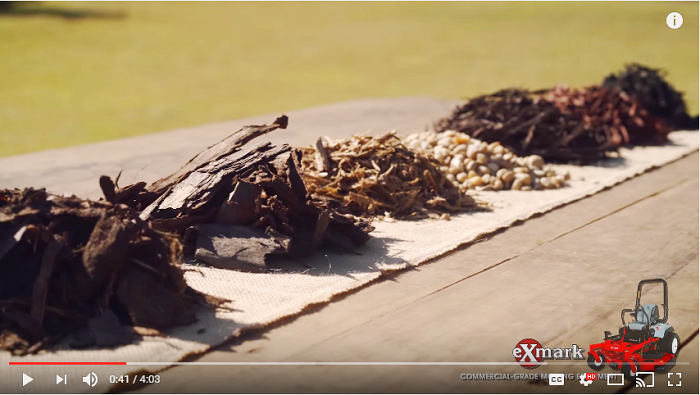
There are a ton of mulching options to choose from…but don’t let that overwhelm you. To determine which is right for you, simply think in terms of functionality, aesthetics, and budget. Below you’ll find a write-up on some of the most popular mulching options.
Pine Straw
Pine straw is popular where I live…in the Atlanta area. One of the primary reasons is that compared to the other mulches you can buy, you get the biggest bang for your buck with pine straw. Also, given that we have a ton of pine trees, using pine straw will not only appear natural, Mother Nature helps foot the mulching bill.
In addition, since pine needles are lightweight installation of pine straw is easier than most other options. Lastly, with their interlocking qualities, pine straw also tends to stay in place in heavy rains better than some of the other mulches — making them a great choice for sloped beds.
All that said, some people just don’t like the look of pine straw. And good for them there are other options to consider. So keep reading.
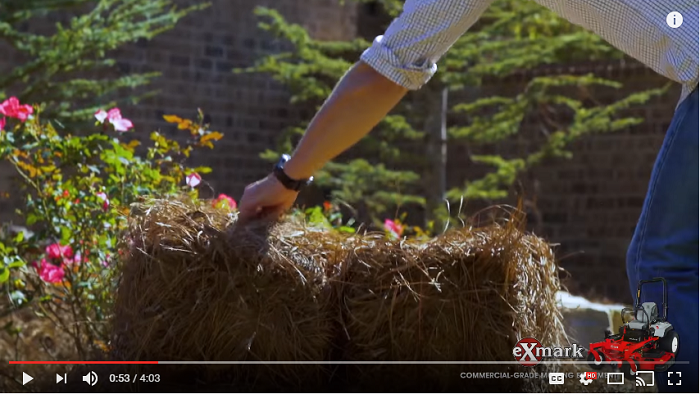
Hardwood & Dried Wood Mulch
Hardwood mulch is another popular option to consider. I find that most of my clients who choose hardwood mulch over pine straw do so simply because they like the look of it better. The added bonus is that it’s a better weed and moisture barrier than pine straw. One of the primary downsides to hardwood mulch is that it can be more expensive.
Dyed wood mulch is another option that many people choose—primarily because there are several colors to choose from. But I have to warn you, although the dye used to color this type of mulch isn’t toxic, some dyed wood mulches are made from recycled wood that may contain additives that are toxic…like pressure treated wood. And that’s not good. That said, just make sure that the mulch you choose is made from raw wood vs. recycled wood.
Another ding against dyed wood mulch made from recycled wood is that it contains very little nutritional value…which is one of the primary reasons to invest in mulch…the health of your plants.
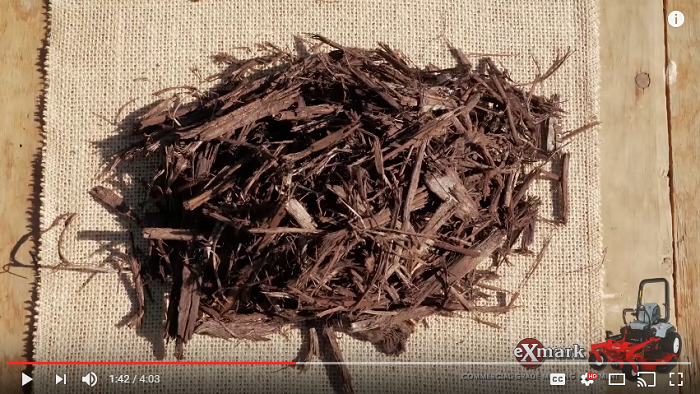
Cypress Mulch
Cypress mulch is another attractive, organic option. It’s naturally more insect repellent and fungus resistance than other options. Cypress mulch also tends to stay put, is easier to walk on, and lasts longer than other mulches. It’s for those reasons that I typically recommend it around play sets and other wooden structures.
Pine Nuggets
Pine nuggets are another great mulching product to consider. Like other organic mulching options, pine nuggets enrich the soil as they break down…which is great for your plants. They are also easy to install and come in various sizes, from mini to jumbo…giving you more options to choose from. The biggest downside to pine nuggets is that they’re prone to float away in heavy rains, which makes them less than ideal in sloped beds.
I often use pine nuggets in annual beds — annual beds are typically flat, pine nuggets serve as a nice visual contrast, and as they break down they contribute to a nutrient-rich soil that the flowers love.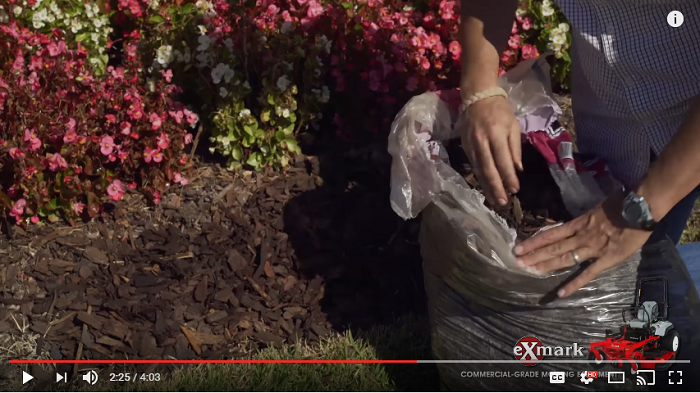
Stones Mulches
Although I rarely use them, stone mulches are popular in certain areas of the country. And in the right setting they can provide a unique, high impact look to your landscape beds and borders.
Unfortunately, while they stay put and don’t break down, stone mulches can eventually sink into the soil, which will require fill-in applications. In addition, when leaf litter lands on other mulches it still looks natural, whereas with stones that’s not the case. So you’ll need keep the areas with stone mulch leaf-free to make sure it stays looking nice.
Lastly, it can also be difficult to add plants in and around stone mulches, and they’re less effective at maintaining soil moisture in sunny areas due to the warmer soil conditions they create, which leads to increased evaporation.
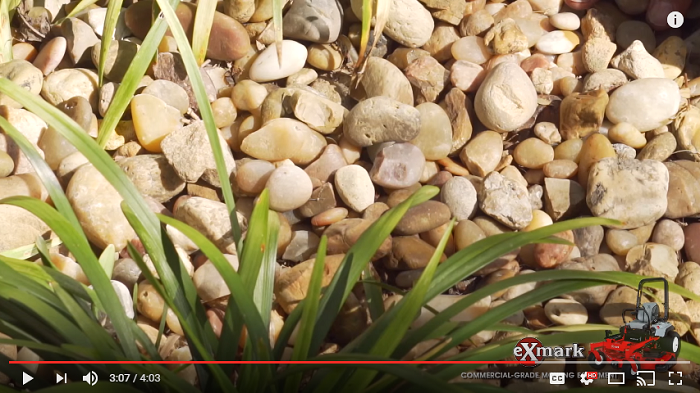
![]()
There you have it…a little goodie on mulching options. Although the ones I described above are some of the most popular, there are many more…grass clippings and shredded leaves are 2 other very inexpensive and environmentally conscious mulching options, for instance.
So which much is right for you depends on your budget, what else is going on in your yard, and your personal preferences. Regardless, adding mulch to your landscape beds really is a must from both a design and functional perspective (i.e., plant health).
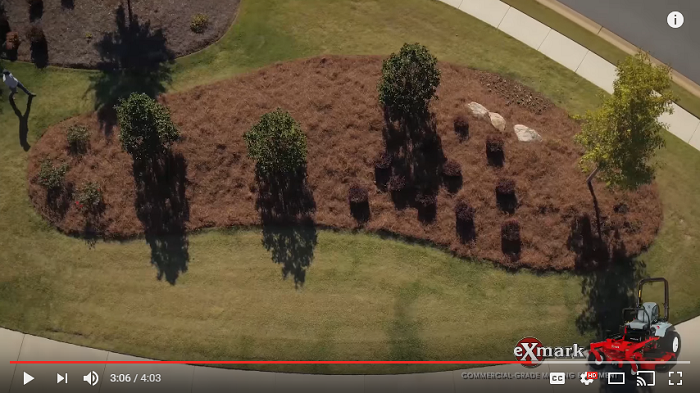
So what kind of mulch do I use in my yard? Pine straw.
Why? I’m cheap…we have a ton of pine trees in our yard, so it looks natural…I like the look of pine straw…and I prefer working out with something other than bags of mulch or rocks.
But again, fortunately there are other options…and hopefully this post and the video helped you figure out which is best for you.
And if you liked the video, make sure to check back in over the next few months for posts on the other Exmark ‘Done-in-a-Weekend’ project videos. Or if you want to check out the videos all at once, go to WeAreExmark.com.
Happy Mulchin’ Friends,

About Exmark: If you’ve never heard of Exmark, they are the premier lawn mower company…making the most innovative, comfortable, durable, reliable and highest quality mowers on the market today. Historically they’ve lived in the commercial mower space…but  they are now offering a line of mowers for homeowners who have a couple of acres or more of land. So if that’s you…that means you get to benefit from all the bells and whistles and advancements that the pros have enjoyed. To learn more, check out these videos on Exmark’s YouTube channel.
they are now offering a line of mowers for homeowners who have a couple of acres or more of land. So if that’s you…that means you get to benefit from all the bells and whistles and advancements that the pros have enjoyed. To learn more, check out these videos on Exmark’s YouTube channel.
You may also enjoy these posts from RYG ...
If you're not already subscribed to RYG and want to get periodic updates, links to new posts & other ground redeeming info ... just enter your email address below. Easy as that!

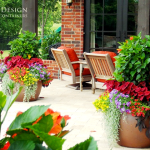
![Basic How-To’s for Planting Plants [Video for Exmark]](https://redeemyourground.com/wp-content/uploads/2017/03/Redeem-Your-Ground-Exmark6-150x150.png)

![How to Hang String Lights [Video with Exmark]](https://redeemyourground.com/wp-content/uploads/2015/06/4th-of-July_String-lights-_-RYGblog-150x150.jpg)
![Walk This Way…Adding Paths to Your Landscape [Video for Exmark]](https://redeemyourground.com/wp-content/uploads/2016/03/Creeping-Jenny-RYGblog-150x150.jpg)
Hello and thank you for all of your very helpful tips and advice! My ? Is……can I use pine mulch from last year that I had raked up and threw onto a pile where it has been all winter covered with snow?
Hey Sandy, I don’t see why not. Just note that they have probably already started to break down, so they won’t last as long in your beds. Let me know how it turns out. Thanks for reaching out! Take care, D.
I was told not to use oak leaves that was mulched with lawn mover. I was told that nothing will grow in it,.. Is that true?
Hey Terry…thanks for reaching out. I have heard that too, but I don’t believe that there’s any truth in it. I have 3 HUGE oak trees in my front yard and I try to keep everything that falls on my ground somewhere on my ground. So the leaves from these 3 lovely ladies get blown in to all my landscape beds…off the lawn and hardscapes…and my plants are growing just fine. That said, there are a few things to consider related to oak trees and oak leaves.
First…the oak trees themselves…look up and down. An oak tree’s canopy can be pretty dense…creating significant shade. And an oak tree’s roots are highly competitive…soaking up as much water & nutrients as they can. These 2 things create a growing environment that narrows what you can plant underneath them (i.e., dry & shady). So this may be why some people believe that it’s the oak leaves used as mulch that’s causing their plants to struggle…but I just don’t agree.
Second…the oak tree’s leaves. I would contend that they are a great source of nutrients for the soil in which you plant your trees and shrubs. It is true that oak leaves (and acorns) are acidic and they take longer to decompose than other leaves. However, the amount of acid that would make its way into the soil wouldn’t likely adversely impact the soil. But even if the oak leaves make the soil more acidic, before you can make any real determination as to if it’s a good or bad thing you would have to consider what the pH level of your soil is to begin with and then what type of plants you have growing in that soil. If the soil is alkaline, it could use a little spice…if you have acid-loving plants (e.g., azaleas, rhodies, oak trees(!), evergreens, etc.) they would appreciate what the oak leaves have to offer.
As for the oak leaves taking longer to decompose…that’s either a good thing or something that’s easily addressed if it’s a bad thing. If you’re using the oak leaves as mulch for weed control, unprocessed oak leaves would create a stronger barrier. (That being said, you wouldn’t want them to remain on top of your lawn or ornamentals.) But if that’s not what you’re looking for…simply process them with your mower, shredder, or chipper…or you could compost them…which tends to make any organic matter more alkaline.
So the net-net of all of this is…you should feel more than comfortable using your oak leaves as mulch.
Thanks for your question Terry…take care, D.